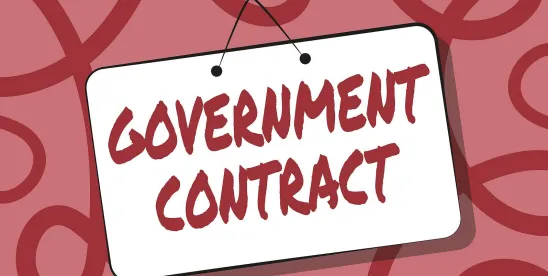Bid rigging is a persistent concern in the federal procurement sector. Across all federal contracting agencies, bid rigging leads to substantial taxpayer losses while also resulting in inefficiencies, inferior work, and other tangible and intangible losses. As a result, the U.S. Department of Justice (DOJ) is active in pursuing bid rigging investigations, and it works closely with contracting agencies to determine when federal charges are warranted to maintain the integrity of the competitive bidding process. Contracting agencies can take action in response to concerns about bid rigging as well—including suspending and debarring contractors suspected of all forms of collusion to win government contracts.
To determine when enforcement action may be warranted, the DOJ looks for several red flags, and it encourages contracting agencies to be on the lookout for these red flags as well. Crucially, however, while these red flags may be indicative of collusion, they are not conclusive in and of themselves, and contractors accused of bid rigging schemes will have strong defenses available in many cases.
“In the federal procurement sector, bid rigging accusations can take many different forms. For contractors accused of bid rigging, building an effective defense starts with gaining a clear understanding of all relevant facts as well as the specific allegations at issue.” – Dr. Nick Oberheiden, Founding Attorney of Oberheiden P.C.
(Some Of) The DOJ’s Red Flags for Federal Bid Rigging
The DOJ’s red flags for bid rigging in the federal contracting sector include (but are not limited to):
1. “The Same Company Always Wins”
If “[t]he same company always wins a particular procurement,” the DOJ considers this to be a red flag for collusion between bidders. The DOJ notes that this outcome “may be [even] more suspicious if one or more companies continually submit unsuccessful bids.”
2. “The Same Suppliers . . . Seem to Take a Turn Being the Successful Bidder”
If “[t]he same suppliers submit bids and each company seems to take a turn being the successful bidder,” this can trigger scrutiny for possible bid rigging as well. These cases typically focus on a specific form of bid rigging known as bid rotation, and competitors are especially likely to face scrutiny if “[a] strict bid rotation pattern defies the law of chance and suggests collusion is taking place.”
3. “Some Bids Are Much Higher Than Published Price Lists”
When evaluating bids, federal agencies don’t just look at the bids themselves. They also consider outside data sources when deciding whether it is in taxpayers’ best interests for them to accept a particular bid. These outside data sources include bidders’ published price lists (among many others). The DOJ considers bidders’ published price lists and other publicly available sources of information when determining whether law enforcement action may be warranted as well.
4. “Some Bids Are Much Higher Than . . . Previous Bids By the Same Firms”
Along with pricing terms that are inconsistent with companies’ published prices, pricing terms that are materially different from those contained in companies’ prior bids can raise concerns as well. While higher prices may be fully justified—especially in today’s market—the DOJ nonetheless considers this to be a red flag for possible bidding fraud.
5. “Fewer Than the Normal Number of Competitors Submit Bids”
In many industries, federal contracting is a small fraternity. Federal agencies know the key players, and the key players know one another as well. When this is the case, if “fewer than the normal number of competitors submit bids,” the DOJ can view this as a red flag that some would-be competitors are colluding in an illegal bid-rigging scheme like bid suppression.
6. “A Company Appears to Be Bidding Substantially Higher on Some Bids Than [Others]”
If “[a] company appears to be bidding substantially higher on some bids than other bids, with no apparent cost differences to account for the disparity,” this can also lead to scrutiny from the DOJ. Depending on the circumstances, the DOJ may consider this to be potential evidence of price fixing, complementary bidding to alternate the winning bidder, or another form of bid rigging.
7. “A Successful Bidder Subcontracts Work to Competitors”
Subcontracting work to competitors is another red flag for bid rigging according to the DOJ. This is especially true when the competitors that receive subcontracts submitted unsuccessful bids on the same project.
8. “A Company Withdraws Its Successful Bid”
While there are a variety of reasons why a company may ultimately decide to withdraw a successful bid, doing so will often invite scrutiny from both the contracting agency and the DOJ. According to the DOJ, withdrawing a successful bid is particularly suspicious when the winning company “is subcontracted work by the new winning contractor.”
9. “Identical Prices . . . Especially When . . .”
The DOJ has indicated that identical prices can be a red flag for bid rigging both when submitted by the same contractor across multiple bids and when submitted by competing bidders (despite also indicating that material pricing changes can also be a red flag). According to the DOJ, identical pricing is of concern “especially when” either: (i) “[p]rices stay identical for long periods of time;” or (ii) [p]rices previously were different.”
10. “Price Increases Do Not Appear To Be Supported By Increased Costs”
While identical pricing can peak the DOJ’s interest, the DOJ also takes the position that an investigation may be warranted if “[p]rice increases do not appear to be supported by increased costs.” As a result, when increasing prices from prior bids, contractors should ensure that they have sufficient documentary justification on hand.
11. “[B]id Forms Submitted By Different Vendors Contain [Similar] Irregularities”
Generally, bid preparation should be an independent process among the various companies competing for government business. As a result, if multiple bidders submit bid forms with similar irregularities, “such as identical [mis]calculations or spelling errors,” this can be a strong red flag for fraud.
12. “[B]id Forms Submitted By Different Vendors Contain . . . Similar Handwriting, Typeface, or Stationery”
Even if competing bids do not contain similar irregularities, if they include similar “handwriting, typeface, or stationery,” this is also likely to trigger scrutiny from the DOJ for possible bid rigging.
13. “Bid or Price Documents Contain . . . Last-Minute Price Changes”
If a bidder’s submission contains “whiteouts or other physical alterations” that suggest “last-minute price changes,” the DOJ may consider this to be evidence of price fixing or another form of bid rigging as well. Of course, people make mistakes—and bidders often work on their bids up to the submission deadline—so these can also have a perfectly innocuous explanation.
14. “A Company Submits a Bid . . . It Is Incapable of Successfully Performing”
The DOJ notes that a bid is “likely a complementary bid” if it is submitted by a company that is incapable of meeting the contracting agency’s needs. Oftentimes, however, the DOJ makes this preliminary assessment based on a company’s past performance and not its current capabilities.
15. “A Company Brings Multiple Bids to a Bid Opening”
If a company prepares multiple bids and “submits its bid only after determining . . . who else is bidding,” the DOJ considers this to be a red flag for bid rigging as well. While this may be harder to justify in some cases, there are legitimate explanations for this approach as well.
What Are the Potential Consequences of Federal Bid Rigging Allegations?
Let’s say your company (or one of your firm’s clients) is facing scrutiny from the DOJ for potential bid rigging. What is at stake? The short answer is, “A lot.” Depending on the circumstances involved, federal bid rigging investigations can lead to outcomes including:
- Debarment or Suspension from Federal Procurement – Contractors and subcontractors accused of bid rigging can face debarment or suspension from federal procurement. While neither of these is permanent, generally speaking, even temporarily losing the ability to perform under federal contracts can have significant financial implications for companies of all sizes.
- Sherman Act Prosecution – Big rigging violates the Sherman Act’s prohibitions against anticompetitive activity. In Sherman Act prosecutions, companies can face up to a $100 million fine, while individuals can face a $1 million fine and up to ten years of federal imprisonment.
- False Claims Act (FCA) Prosecution – Bid rigging allegations can lead to prosecution under the False Claims Act as well. Under the criminal provisions of the False Claims Act, willful violations carry six-figure fines (for both companies and individuals) and up to five years of imprisonment.
- Other Federal Charges – Along with charges under the Sherman Act and False Claims Act, bid rigging allegations can also lead to charges for conspiracy, violating federal antitrust laws, fraud against the government, and other federal crimes. These crimes also carry substantial fines and prison time.
- Settlement Agreement, Administrative Agreement, or Voluntary Exclusion Agreement – When contractors, subcontractors, or their owners or executives are at risk of facing suspension, debarment, or criminal prosecution, negotiating with the government may be the best approach. The DOJ will be willing to settle criminal bid rigging investigations in many (but not all) cases, and those facing suspension or debarment may be able to enter into an administrative agreement or voluntary exclusion agreement to protect their ability to bid on federal contracts.



 />i
/>i

